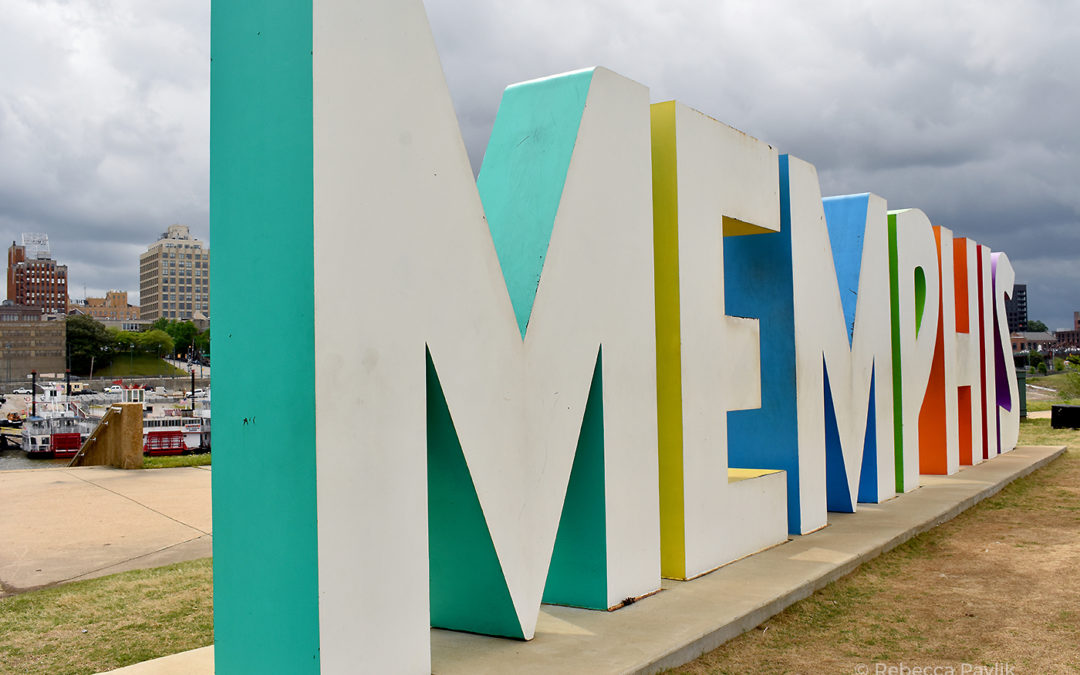Memphis has been made famous by its music — by Elvis, Johnny Cash, B.B. King and countless others. It’s also known for the Mississippi River and pivotal moments in civil rights movement, but having never visited Memphis before, I really didn’t know what to expect, in terms of the town itself.
I held in my mind, not a single image of what Memphis looked like. Not one. Not one building, not one natural wonder — I could not even conjure up any images of the Mississippi River. Memphis was a complete mystery to me. A blank slate. I only held songs in my mind, such as Proud Mary, by Creedence Clearwater Revival, Graceland by Paul Simon, Memphis Tennessee, by Chuck Berry, I’ve Been to Memphis by Lyle Lovett, and one of my favorites, Walking in Memphis by Marc Cohn — the song that kept playing in my head the entire week leading up to my trip. Over 100 songs have been written about Memphis or mention Memphis in the lyrics. I had lots of song lyrics and melodies, but no images.
Downtown Area
When I arrived I was immediately struck by how old and well preserved the small downtown area was. Modest old buildings had not yet been leveled for giant Walmarts, Targets or 30-story office buildings. It was old, somewhat downtrodden, a little gritty, but in a refreshing way — a nostalgic way that reminds you of the 1950s or 60s. The downtown was smaller and more charming than I had imagined, especially Main Street, with old brick buildings, and even brick streets. There are no cars on Main street, just the old Trolleys and lots of horse carriages. The entire downtown is walkable. I walked everywhere and everything is close by. No need for an Uber, although I did ride the trolley a few times (which was free when I was visited).
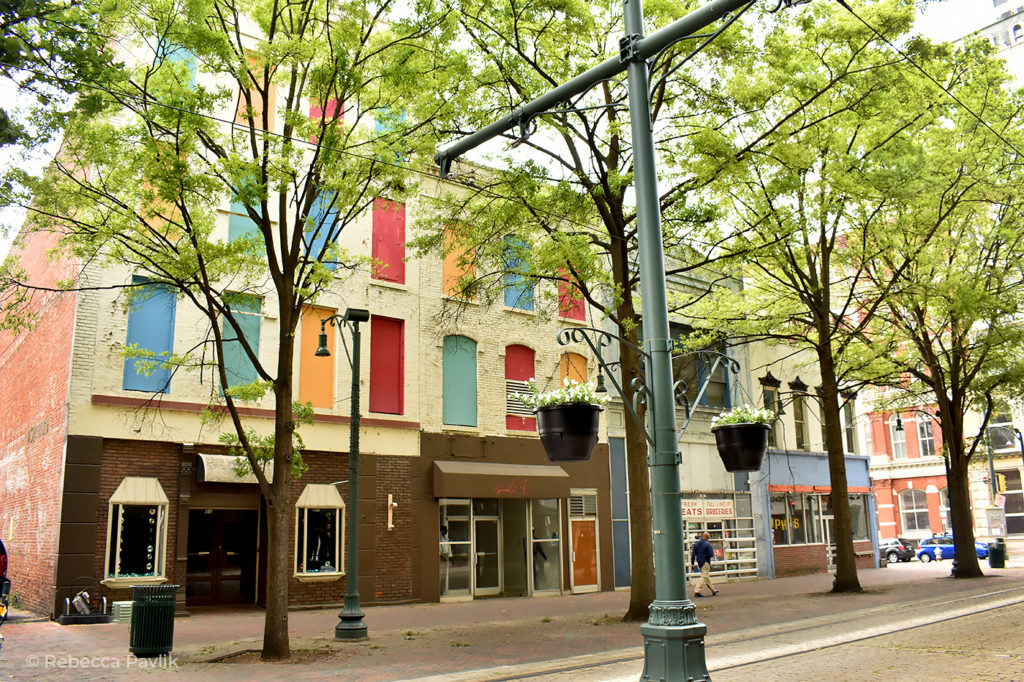
Main Street, downtown. It’s very quiet and there is no car traffic, just trolleys and horse carriages.
Beale Street: Home of the Blues
In addition to being a National Historic Landmark, Beale Street was officially declared the “Home of the Blues,” by an act of Congress in 1977. Surprisingly, the Beale Street Entertainment District is only three blocks long — not even 2 miles — and ends rather abruptly. A brisk walk down this famous street would only take about take you about five minutes. For the uninitiated, it’s one big party with lots of blues clubs, but to truly appreciate Beale Street’s significance, it’s good to know the history of Beale Street and all the legendary blues, rock-a-billy, jazz and soul artists who started out there.
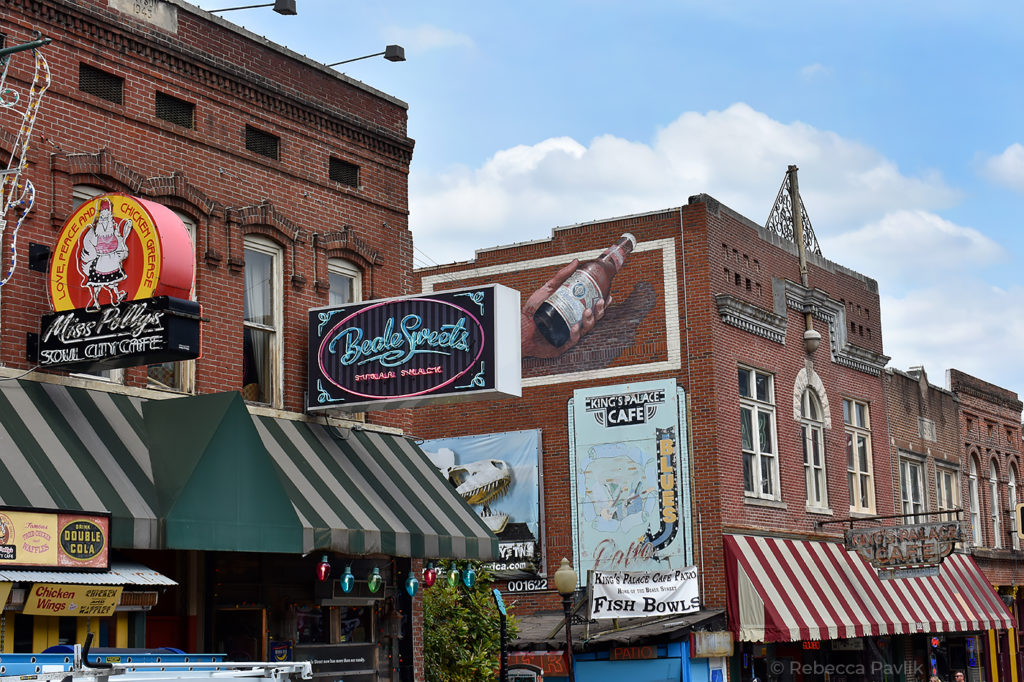
Old buildings on Beale Street, downtown Memphis
While these days it may be rather touristy, Beale Street is still pretty low-key and casual in many ways, at least during the day. At night however, the whole scene changes and the blocked-off street turns into one big party. It can get a little rowdy, even more so after a big game. Luckily, this short stretch of Beale, with all the bars, restaurants and blues clubs, is closed off to car traffic. When the sun sets, Beale Street is all about the music — with blues and rock ’n roll booming out of every bar, nightclub and cafe.
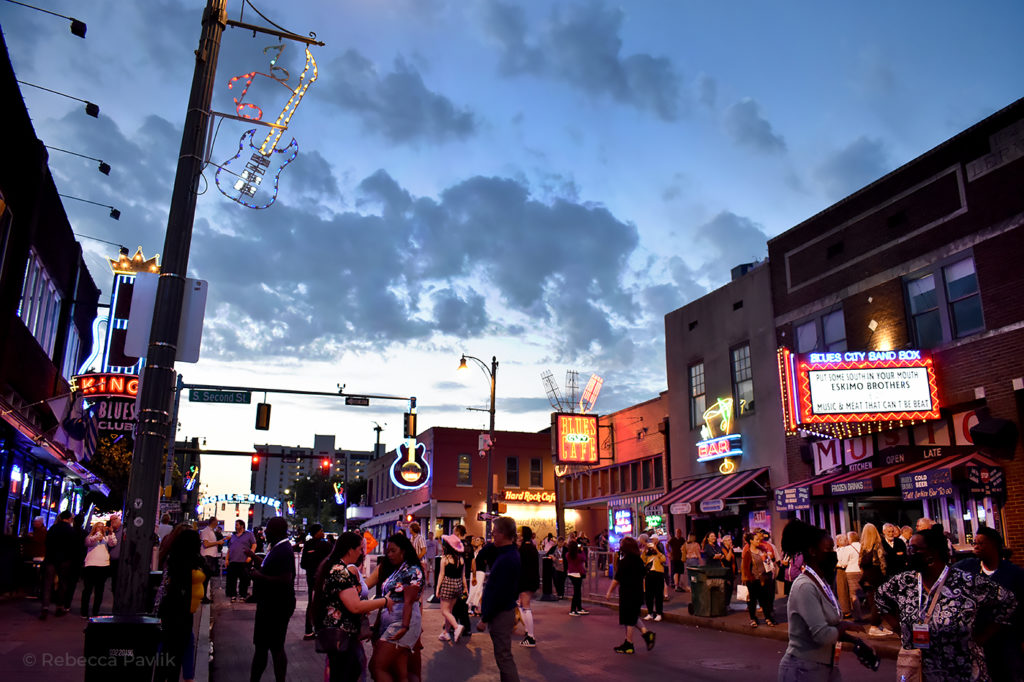
Beale Street Entertainment District, as the sun sets, downtown Memphis
We encountered a lot of cover bands on Beale Street, catering to visitors who’ve come to hear to “the blues.” While some performers were better than others, there were so many talented singers and musicians that we came across just strolling down Beale Street. The windows of many clubs are open and you can stand outside and enjoy to the music. I wish we could have listened to more bands, but there is only so much time, and you can’t really go in, take up space and not order a meal or a drink (although, that’s pretty much what we did at B.B. King’s and they didn’t seem to mind). On our last day, we sat for several hours during the day at B.B. King’s Blues Club and enjoyed a rock/blues band playing cover tunes. A lot of the blues clubs don’t charge a cover charge which is great.
The party atmosphere of Beale Street is certainly festive, but it did feel a little forced at times, more like a theme park than a real city street. On the one hand, Beale Street is not quite what I had imagined, as it’s such a short little stretch of blues clubs. On the other hand, I’ve never seen so much live music concentrated in such a small area. All that wonderful music, combined with the incredible history of Beale Street, made it the highlight of visiting Memphis.
Music History and Museums
So many legendary recording artists came out of Memphis and performed and recorded in Memphis, from B.B. King and Otis Redding to Elvis Presley and Johnny Cash. Blues legend B.B. King got his start performing on Beale Street. There were so many music “firsts” that occurred in Memphis, from the blues and rock ’n roll, to soul music and country. Luckily for music lovers and history buffs, many of these famous recording studios, record companies and other sights have been preserved and are now museums and historic sights.
In addition to Graceland — the estate of Elvis Presley and Memphis’s most famous tourist attraction — Memphis is dotted with places that tell the story of American music, starting with the music of Black musicians and the blues, followed by the birth of rock-a-billy, rock ‘n roll, and how it all went mainstream with people like Elvis, Jerry Lee Lewis, Johnny Cash, and Carl Perkins. Touring these places, or even just taking a guided tour with Backbeat Tours, gives visitors fascinating look back at the humble beginnings of America’s music industry — how it started and how it evolved.
Sun Records, now a popular tourist attraction, is probably best known for being the first label to record Elvis Presley, Jerry Lee Lewis, Roy Orbison, Johnny Cash and for bringing the music of Black artists and rhythm and blues to a white, mainstream, and much larger, audience. Elvis Presley used to hang out on Beale Street listening to the Black artists play the blues and his earliest recordings were with Sun Records. Many great blues artists also recorded at Sun Records, including Howlin Wolf, Bobby “Blue” Bland, and Rufus Thomas.
The Stax Museum of American Soul pays tribute to Stax Records and recording studio which produced some of the biggest hits of the 1960s, including Otis Redding’s Sittin’ on the Dock of the Bay and Try a Little Tenderness, as well has hits by Sam and Dave, Booker T. & the M.G.s (the house band for nearly all recordings at Stax), Rufus Thomas and Carla Thomas. Other big names include William Bell, Eddie Floyd (Knock on Wood) and the writing team of Isaac Hayes and David Porter.
For even more music history, memorabilia and trivia consider visiting The Memphis Music Hall of Fame museum and the Memphis Rock n Soul Museum. I toured the Memphis Music Hall of Fame which was worth the small price of admission. It’s a small museum, which was nice because it was not overwhelming. It mostly showcased a lot of cool costumes, signed guitars and other memorabilia.
Memphis History and Civil Rights landmarks
Almost every corner of Memphis has a plaque dedicated to someone who made history. Memphians seemed extremely proud of their city’s rich heritage, its music legends and civil rights heroes. These historic plaques pop up on almost every block of downtown Memphis. Be on the lookout for these fascinating little history lessons — you’ll get dribs and drabs of history and trivia on many interesting topics, from Johnny Cash and Martin Luther King, Jr., to Danny Thomas and the Piggly Wiggly grocery store chain, America’s first self-service grocery store, founded in 1916.
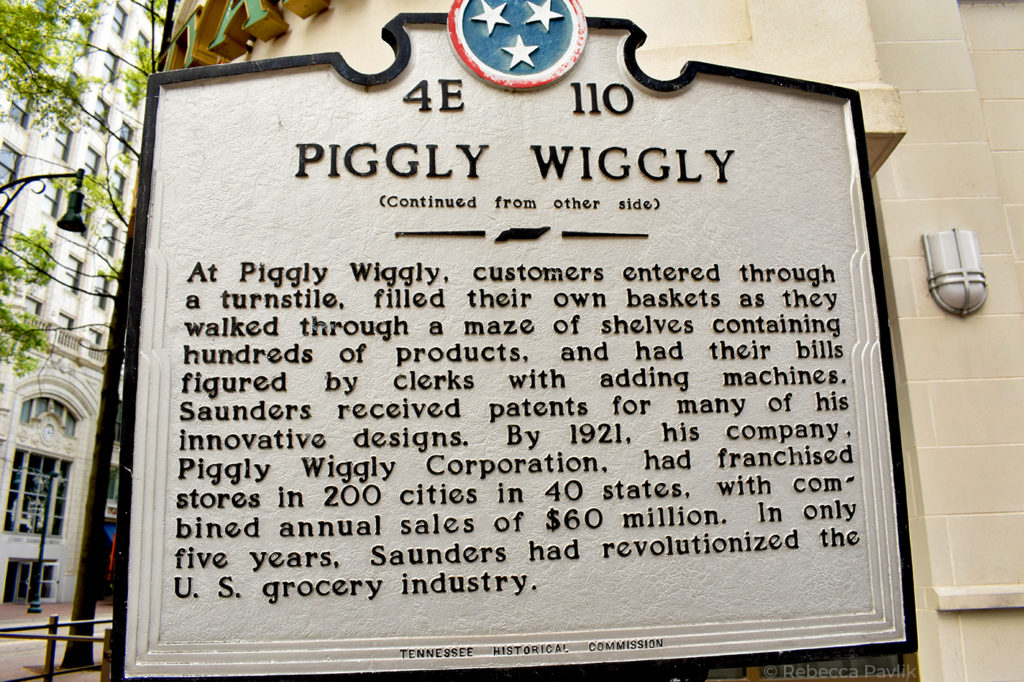
Piggly Wiggly historic marker, downtown Memphis
Certain historic sights were much more emotionally moving than I anticipated, especially the main three sights associated with Martin Luther King, Jr., most notably, the place of his assassination, the Lorraine Motel, which has been turned into the National Civil Rights Museum. Other moving civil rights sights include the Mason Temple where where Martin Luther King, Jr. gave his famous “I’ve Been to the Mountaintop” speech, and the iconic Clayborn Temple where the sanitation workers who protested gathered and organized the Sanitation Workers’ Strike of 1968. The church now has a beautiful memorial with a sculpture that reads “I Am A Man,” the slogan used by the sanitation strike protesters which became synonymous with the Civil Rights movement.
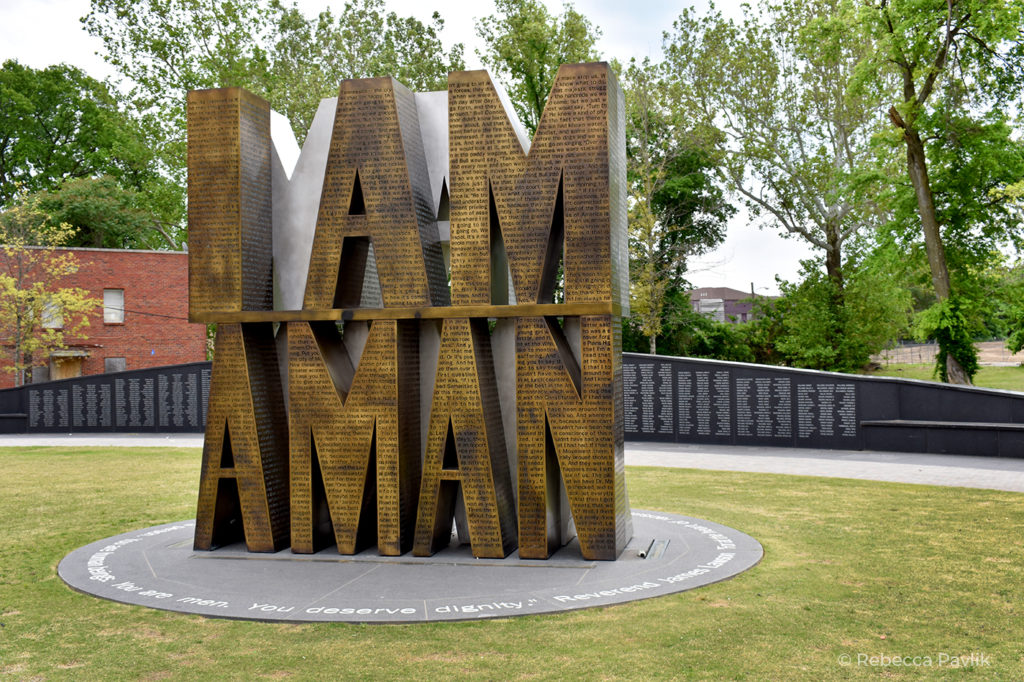
“I AM A MAN” sculpture and civil rights monument at the Clayborn Temple church
One of the more interesting sights is an old house, now a museum, called Slave Haven Underground Railroad Museum, part of the Underground Railroad that hid enslaved Black people seeking freedom during the Civil War.
Memphis has Exceptional Guided Tours
There is so much history and music trivia in this small town, that I highly recommend taking a guided tour, if you have the time. I did two such tours and the amount of information the tour guides packed into two hours was pretty incredible. The first tour was called Backbeat Tours, which highlights the history of the blues and the birth of rock and roll in Memphis. Our tour guide, Davy Ray Bennett, a talented musician with a great voice, also sang many of the songs discussed on the tour. It was a musical performance as well as tour. Mr. Bennett was extremely knowledgable about Memphis music history and trivia, and furthermore, made it interesting even to those of us who weren’t necessarily big music trivia buffs.
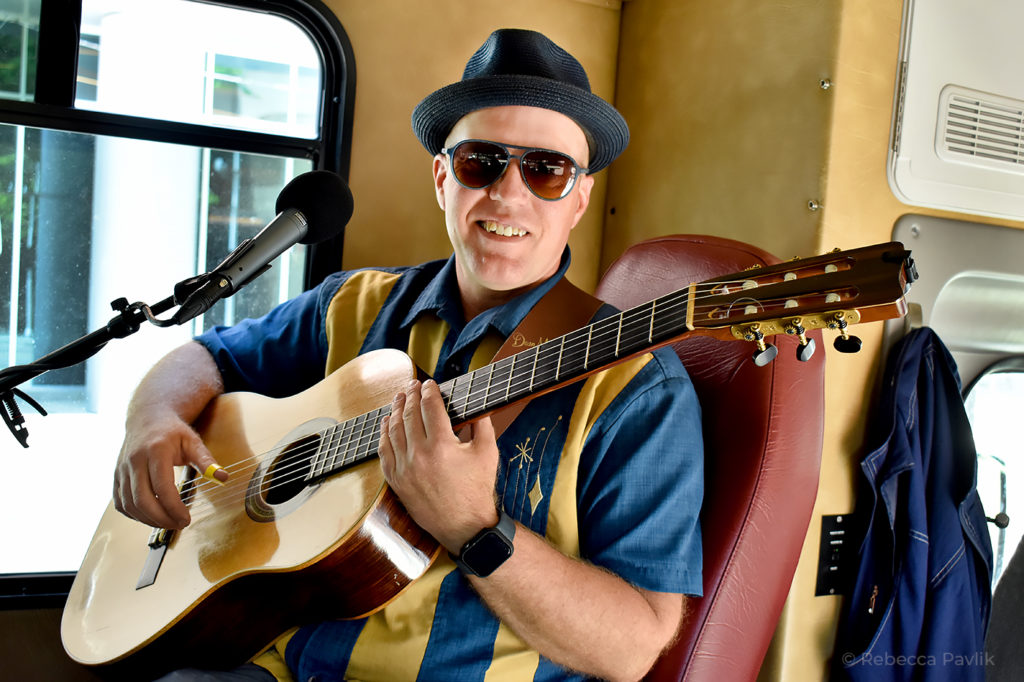
Davy Ray Bennett, our tour guide for Backbeat Tours, performed and gave an excellent tour of historic music sights
The other tour I highly recommend is called A Tour of Possibilities. “Queen,” our tour guide, gave a very fascinating tour of Black history and civil rights in Memphis. I must say, that I found Queen to be one of those rare souls who found has her true calling. She can both educate and entertain her guests in such a way that you will end up loving Memphis, with its complicated history, as much as she does.
Other fun tours to consider include food tours with Tastin’ ‘Round Town, a ghost tour with Historical Haunts or a craft brewery tour with the Memphis Brew Bus.
Memphis has its music heroes and civil rights heroes but one the town’s most beloved celebrities is not Elvis, or even B.B. King, but actor Danny Thomas, who founded and built St. Jude’s Children’s Hospital. I’ve seen the St. Jude’s Children’s Hospital commercials my entire life, and never knew anything about the actual hospital. The hospital and the fascinating story of why Danny Thomas built it, was highlighted on both the tours I took. Both of the Memphian tour guides seemed extremely proud of the hospital and everything it does to treat children — free of charge!
The Mighty Mississippi River
There are numerous ways to get acquainted with the Mississippi River in Memphis. We took a Memphis Riverboats dinner cruise and while it wasn’t perfect (the music was annoyingly loud, even on the top decks due to a giant speaker) and we ended up on a boat with a tour bus filled with a bunch of wild, partying seniors — which I have no problem with, but logistically, because they were seated at a long table in the middle, like a wedding party, the group took over the place. I actually felt a little sorry for a few of the young couples who probably thought they were going to have a more upscale, elegant, romantic evening. Even my partner, who is in his 60s seemed annoyed at one point by the way the senior tour group dominated the evening. It really wasn’t their fault, it was more the management’s fault for the awkward seating arrangement (they should have broken them up and sat them at a small tables). I must admit though that the partying seniors were a lot of fun and danced like nobody’s business.
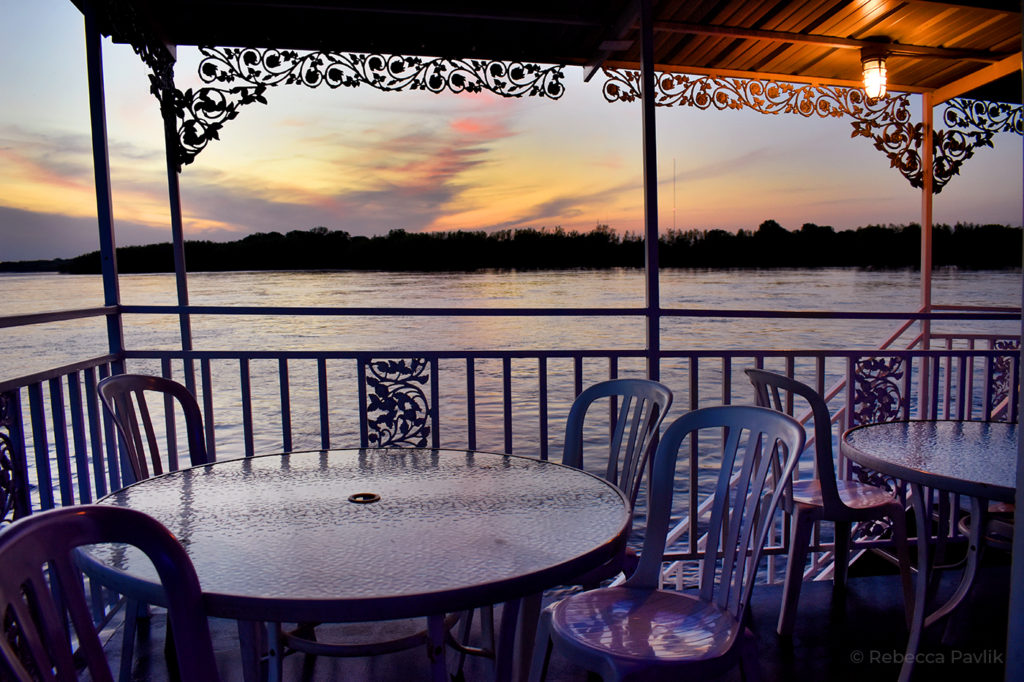
Mississippi Riverboat tour and dinner cruise, as the sun sets
I do recommend doing a riverboat tour because it’s fun to get out on the the Mississippi River and the tickets were pretty inexpensive. Our old-time riverboat with all the upper decks was really cool and provided amazing views of the downtown Memphis. At night you get a front row see to the beautiful light show of the Hernando DeSoto Bridge. Their daytime cruise is less expensive and is more of a sightseeing tour.
I also highly recommend walking over to Mud Island Park if you have time. Again, this was a very short walk from our hotel. You can walk right over the Mississippi River and explore the park and fascinating miniature replica of the Mississippi River that is part of the park. You can also get great shots of the very cool “MEMPHIS” sign and the downtown from the vantage point of the river.
Beyond Beale Street: See a Play, go to the Opera, attend the Symphony or the Ballet
Before you arrive in Memphis, you might want see what’s playing at some of the other performing arts venues and buy tickets to show. Memphis is really a performing arts town and has so much going on beyond Beale Street and the Blues. For a big splashy Broadway production, see what’s playing at the Orpheum Theatre, a beautiful 1928 theater that hosts the big touring Broadway plays. The Orpheum is located at Beale and Main Street, so if you’re staying downtown, you can walk. For classical performances, check out the Memphis Symphony Orchestra, Opera Memphis, and for dance, Ballet Memphis. Memphis also has a bevy of smaller playhouses including the Playhouse on the Square and the Hattiloo Theatre, with features plays by Black playwrights.
A Few Memphis Food Recommendations
While I’m not a big foodie, I certainly appreciate a good meal. I was impressed with the number of great restaurants and the diversity of cuisine. Memphis is famous for barbecue but I somehow managed to not eat at a single BBQ restaurant during the entire week. However, I would like to mention two restaurants that had amazing food: The Flying Fish and Curry N Jerk. I liked The Flying Fish so much that I went back the next day and ordered the same exact thing: fried catfish! The chicken at Curry N Jerk was incredible and well worth the wait (service was a bit slow).
After a week in Memphis, there was still so much more I wanted to experience. Memphis is the kind of place that gets under your skin. It has more heart and soul than most American cities I’ve visited. The locals were warm and friendly, and quite proud of the town’s contributions to music, the recording industry, civil rights and black history, the Grizzlies, and so much more.
I left Memphis with plenty of images in my mind: views of the muddy Mississippi River, the Lorraine Motel, the quiet section of Maine Street with horse carriages and trolley cars, and all the neon and clubs on Beale Street. But I also left Memphis wanting to know more, wanting to return, wanting to see the things I had missed, like Graceland and BBQ restaurants, just to name a few. I think Memphis is one of those towns that’s just good for the soul. So when you’re tired of…whatever it is you might be tired of, in this modern world, head to Memphis. I’ll leave you with one of the coolest songs ever about Memphis that I’d never heard until recently, Memphis in the Meantime, by John Hiatt, (on YouTube), which, pretty much sums it up.
Complete List of Memphis Museums, Attractions, Hotels and Restaurants:
For more information and a complete list of entertainment venues, attractions and historic sights, including the Memphis Zoo, the Memphis Botanic Garden, and the Memphis Brooks Museum of Art, visit MemphisTravel, the official Memphis Tourism site and a great website for all things Memphis.
© Rebecca Pavlik | TravlGusto — All Rights Reserved.

